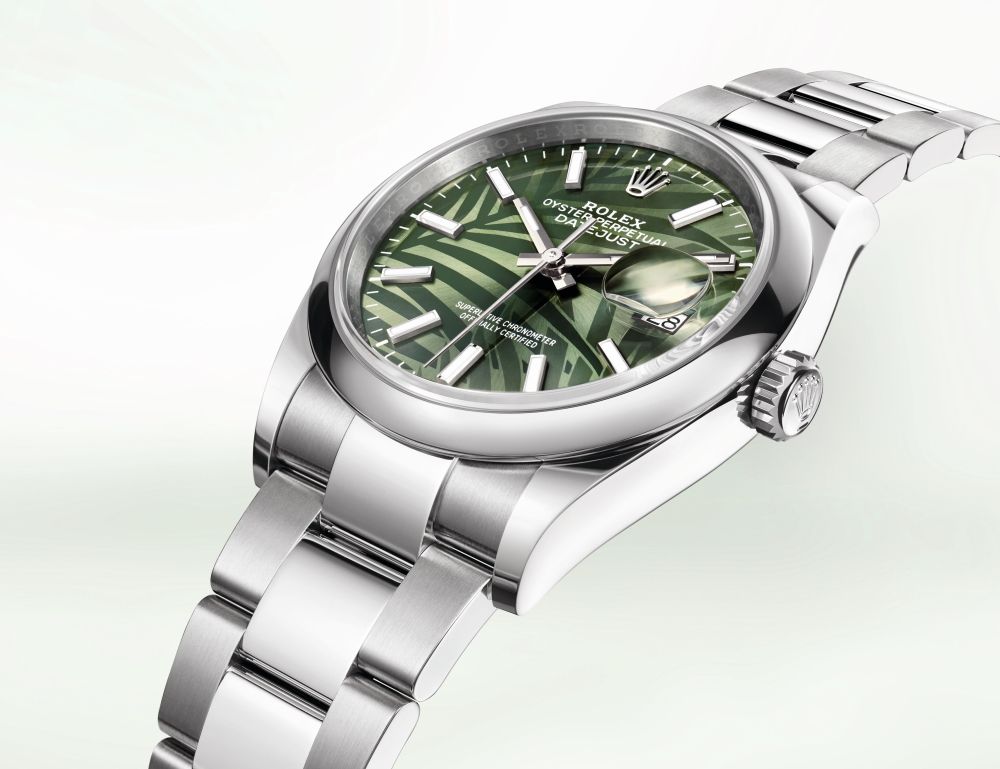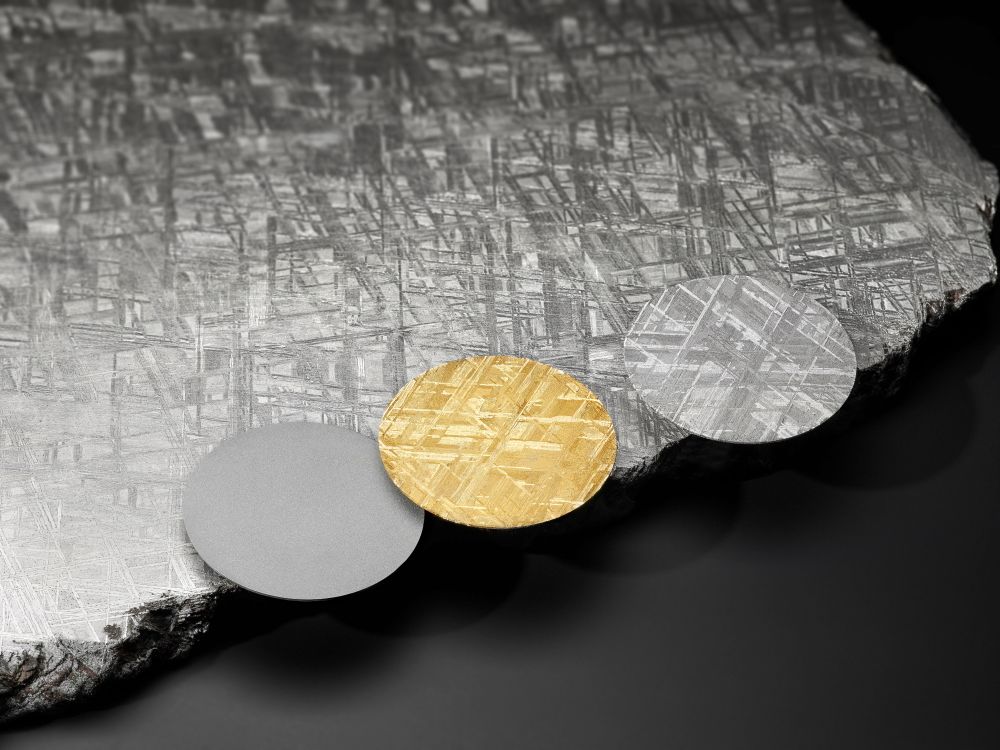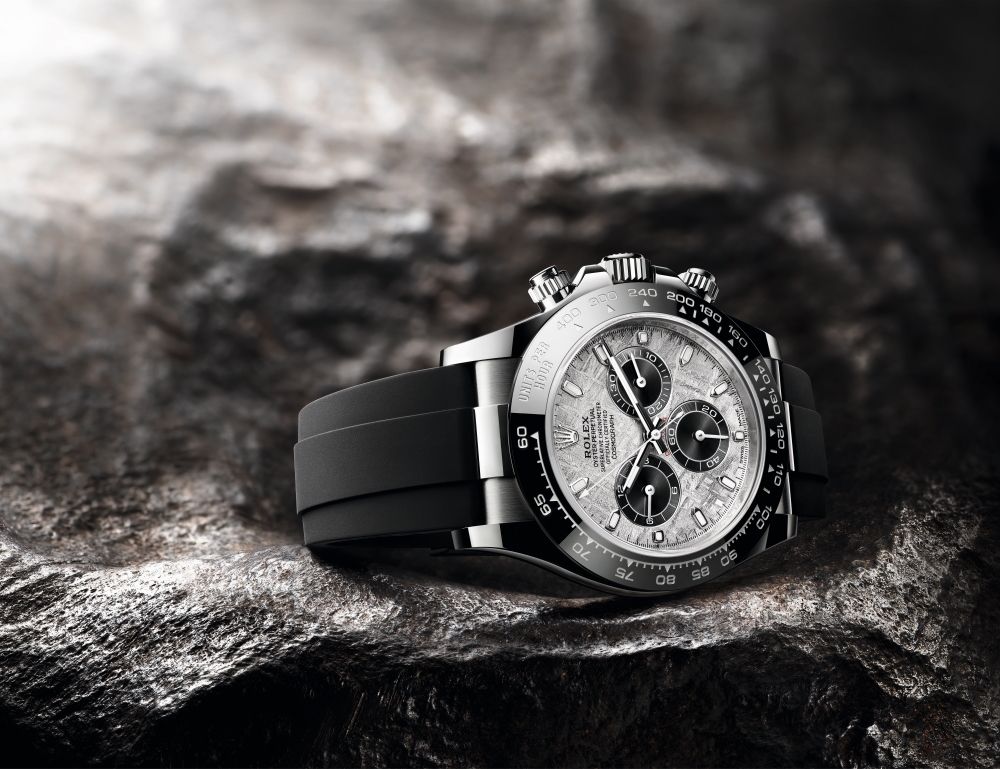The dial is more than the face of a watch; it is an aesthetic element that we notice first and with use, the singular object we look at most often. As a result, it is the one component that we form an eventual emotional attachment to. Only a few microns thick, its often a wonder that this sliver of a part carries distinctive visual flourish of each watchmaker; in some instances, dials become allegories for the face of the brands themselves.
Over the years, watch connoisseurs developed an obsession with the different forms of movement finishing without realising that watchmakers through the ages have paid equal attention to the techniques used in dial finishing. At Rolex, dials shine with spirit and vitality, springing to life as light falls across their surface.
As early as the 1970s, it was Rolex that broke from the norm and adorned its most complicated watch at the time, the Day-Date, with an exuberance of rainbow hues. These watches with “Stella dials” became bright disruptors to a brand that had become synonymous for tough, reliable timepieces for nearly 70 years. This legacy saw a return in the brand’s latest edition of Oyster Perpetual timepieces.
Today, it’s not only light and chroma that brings out the character in the brand’s new dials; they are imbued with other sources of unique, ancient energy. One comes from materials created deep within the Earth. The other has travelled from the outer reaches of our solar system. This energy gives soul and personality to Rolex dials, honed thanks to the experience and knowledge of the brand’s artisans.
Beautiful Faces
Like many other aspects of watchmaking, dial finishing techniques are a curious combination of precision engineering, art and sheer human skill. If a case is the body that houses the mechanical marvel that is gear work, then the dial, the very face of a watch, into which we gaze and fall head over heels in love, is what allows the hundreds of components inside a watch to make sense.
Functionally, the dial is all but a wafer of metal that translates for us that microcosm of wheels, levers, pinions and springs beneath, separating them from the hands and glass, giving us a perspective of time rendered.
Making a dial is less a branch of watchmaking, more a dedicated craft in itself. Since the dial is the part of the watch that speaks to us, it must be not only beautiful and harmonious, but clearly legible. Dial makers and finishers use a number of craftsmanship skills, passed down through generations, calling for both great artistic expertise and use of state‑of‑the‑art technology.

Before an artisan begins shaping a dial, it is a raw metal “canvas” better known to watchmakers as a “blank” of highly polished brass, silver, or an exotic material from the depths of the earth or the reaches of space. The application of finishes then adds texture, pattern and structure to the dial, transforming the unmarked metal into a work of art through a combination of artistry and innovation.
At Rolex, four new versions of its Oyster Perpetual Datejust 36 feature the “palm” and “fluted” dial motifs. The palm motif evokes lush, vibrant tropical forests, while the fluted motif showcases the pattern found on a range of Rolex bezels that has become one of the brand’s signature aesthetic styles. Olive green, silver or golden, they are made from age‑old materials such as copper, zinc, nickel, chromium, titanium and silicon, combined with cutting‑edge technology to create deep, vibrant metallic colours.
Pioneered By Rolex: Meteorite Dials

Rolex was the first watchmaker to develop slices of meteorite into dials, originally featuring them in the Cosmograph Daytona and the Day-Date models at first, then later on precious metal editions of the Datejust, Pearlmaster and GMT-Master II. Meteorites are named after the places where they are found, and there are two that the watch industry favours: Gibeon and Muonionalusta.
Gibeon, believed to have fallen to Earth in prehistoric times, was discovered in Namibia, while the latter, located in Sweden in 1906, is estimated to be about one million years old. At Rolex, each dial is made from a solid slice of the Gibeon meteorite. Contemporary editions of the Oyster Perpetual Cosmograph Daytona have meteorite dials that bear witness to this unfathomable journey through time and space.
The material displays patterns that were formed as the heart of an asteroid cooled slowly on its journey through the cosmos – a process that takes millions of years. Rolex selects metallic meteorite according to very strict aesthetic criteria. Each fragment has a unique internal structure, making every Cosmograph Daytona with a meteorite dial truly one of a kind.
With its origins in the far reaches of the solar system, the material which adorns the dial of these new Cosmograph Daytona watches comes from an asteroid that exploded millions of years ago. On the voyage between planets, fragments of this natural extra-terrestrial material, primarily composed of iron and nickel, cool by a few degrees Celsius every million years, creating unique, distinctive crystallisation within the material that is impossible to recreate on Earth.

Metallic meteorite is rare and challenging to work with – cutting and finishing such a brittle material require time and skill; dials often break in production. Most dials are secured via a baseplate beneath the meteorite slab to offer stability, then treated with an acid-wash finish to bring out its natural crystalline pattern before the great beauty of its interwoven internal structure is revealed.
These fascinating and varied formations are known as Widmanstätten patterns – named after Count Alois von Beckh Widmanstätten, director of the Imperial Porcelain works in Vienna in 1808, who discovered that by heating iron meteorites he could influence and augment the natural colour and lustre of the repeating patterns found in the iron and nickel. The structures themselves are created by the extreme temperature changes that the meteorite undergoes upon entering the Earth’s atmosphere.
The material is magnetic, so it has to be rhodium-plated for use in watches. For its dials, Rolex works with leading experts in the field and selects only the sections of meteorite with a particularly well-formed surface rich in different shapes and reflections. At Rolex, these models are not just timekeeping instruments but emblems of time.
(Images: Rolex)